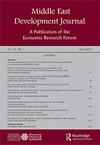New measure of catastrophic health expenditures with application on rural Egypt
IF 0.9
Q4 DEVELOPMENT STUDIES
引用次数: 3
Abstract
ABSTRACT Reducing Out-of-pocket (OOP) health payments is an essential element to protect households from financial risks and eradicate extreme poverty. This paper aimed to provide a new approach for measuring catastrophic health expenditure (CHE) by redefining subsistence spending to comprise the minimum acceptable level of all necessities. The new approach defined OOP health expenditures as catastrophic payments if they undermine a household’s ability to maintain essential needs that are not limited to food needs as assumed by the Capacity to pay (CTP) approach. The equivalence scale is estimated to reflect the dominant consumption patterns and the Cost of Basic Need Approach (CBN) is employed to measure the subsistence spending. We estimated the burden of OOP health payment on household living standards in rural Egypt using data from Household Income, Expenditure, and Consumption Survey in 2015. Rural areas exhibited a considerable incidence of catastrophic payments. Redefining subsistence spending better detected the incidence of catastrophic health expenditure among poor households. The distribution of CHE became highly regressive and demonstrated that catastrophic payments are more concentrated among poor households. Although poor households have incurred relatively small health payments compared to wealthy ones, this has threatened their standard of living. The highest incidence rates of CHE were also observed among uneducated, unemployed, female, elderly heads, among households with chronically ill members, and those who experienced outpatient services. The poor performance of the health insurance system in protecting vulnerable groups from catastrophic payments creates a critical need to redesign its policies and improve its service quality.灾难性卫生支出的新措施及其在埃及农村的应用
摘要减少自付医疗费用是保护家庭免受金融风险和消除极端贫困的重要因素。本文旨在通过重新定义生活支出以包括所有必需品的最低可接受水平,为衡量灾难性卫生支出(CHE)提供一种新的方法。新方法将OOP医疗支出定义为灾难性支出,如果这些支出破坏了家庭维持基本需求的能力,而这些需求不限于支付能力方法所假设的粮食需求。等值量表被估计为反映主要消费模式,基本需求成本法(CBN)被用来衡量生活支出。我们使用2015年家庭收入、支出和消费调查的数据,估计了OOP健康支付对埃及农村家庭生活水平的负担。农村地区出现了相当多的灾难性付款。重新定义生活支出可以更好地发现贫困家庭灾难性医疗支出的发生率。CHE的分布具有高度的递减性,表明灾难性支付更多地集中在贫困家庭中。尽管与富裕家庭相比,贫困家庭的医疗费用相对较少,但这威胁到了他们的生活水平。CHE的发病率最高的人群还有未受过教育的人、失业者、女性、老年户主、有慢性病成员的家庭以及有门诊服务的人。医疗保险系统在保护弱势群体免受灾难性付款方面表现不佳,迫切需要重新设计其政策并提高其服务质量。
本文章由计算机程序翻译,如有差异,请以英文原文为准。
求助全文
约1分钟内获得全文
求助全文

 求助内容:
求助内容: 应助结果提醒方式:
应助结果提醒方式:


